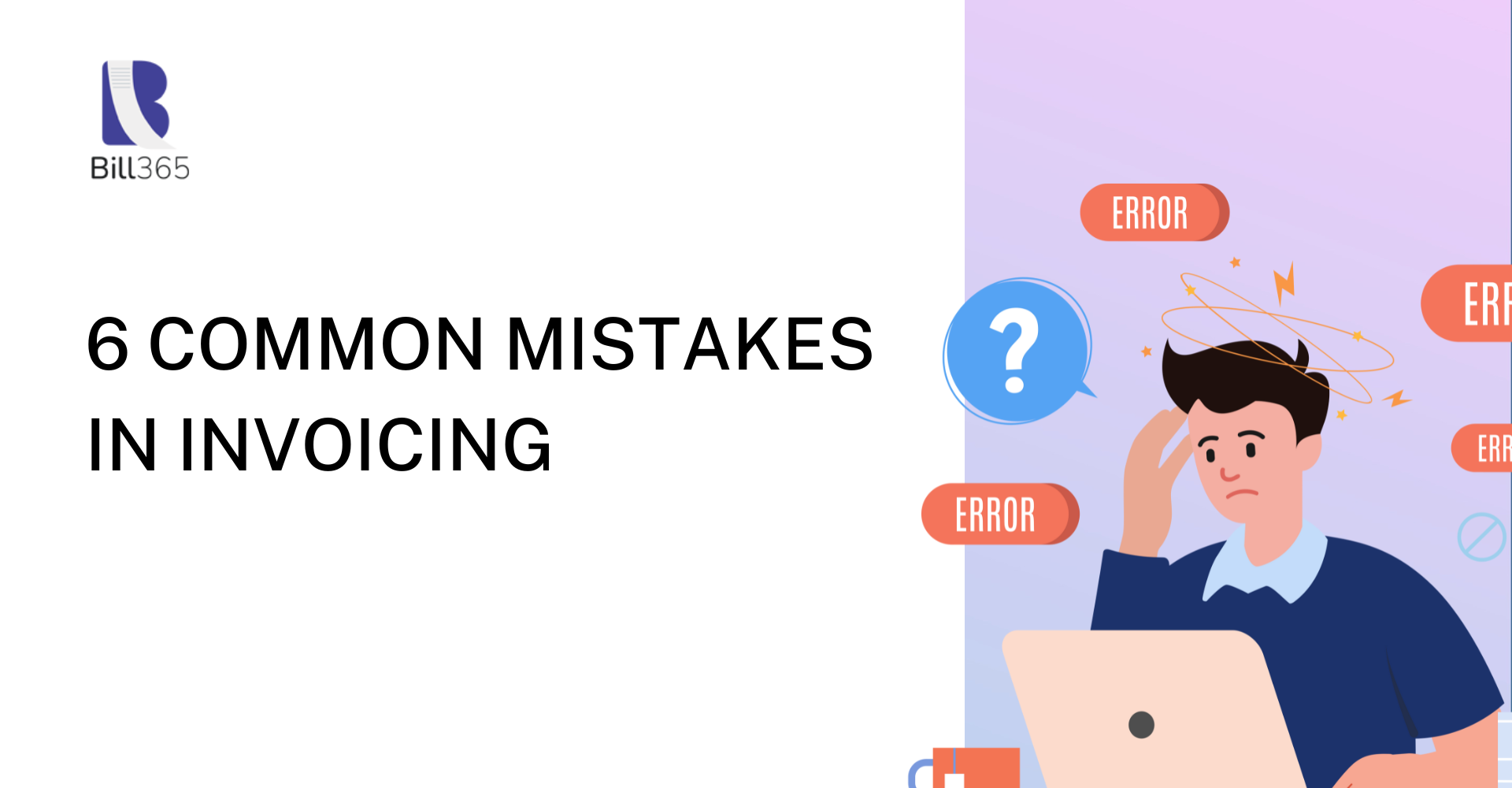
6 Common Mistakes in Invoicing and How to Avoid Them
Invoicing is a crucial aspect of any business, directly impacting cash flow and client relationships. However, common invoicing mistakes can disrupt these operations, leading to delays in payments, strained relationships, and even financial instability. Understanding and addressing these pitfalls is essential for maintaining a healthy business.
A key strategy to mitigate these issues is the use of the best invoicing tools available in the market. These tools are designed to simplify the invoicing process, reducing the risk of errors and ensuring that all necessary information is included.
The benefit of invoicing software goes beyond just error reduction. By streamlining the invoicing process, businesses can improve their cash flow management, reduce the time spent on administrative tasks, and enhance their overall efficiency. By recognizing and addressing these common invoicing mistakes, and leveraging the best invoicing tools, businesses can safeguard their financial operations and foster stronger relationships with their clients. To make your business efficient with online invoicing software, follow the best 10 things that make invoicing software easy to use.
Common Invoicing Mistakes to Avoid
Invoicing is a critical process for any business, as it directly impacts cash flow and client satisfaction. However, even small mistakes in invoicing can lead to significant issues, including delayed payments and strained relationships. Understanding and avoiding these common invoicing errors is key to ensuring smooth financial operations and maintaining strong client connections.

1. Incorrect or Missing Information
One of the most common mistakes in invoicing is the inclusion of incorrect or missing information. This can range from small errors like a misspelled company name or incorrect invoice number to more significant issues such as missing client details, incorrect billing addresses, or omitting essential payment terms.
These seemingly minor errors can have major consequences, including delayed payments, customer confusion, and even legal disputes. To avoid this, it’s crucial to implement a systematic approach to invoicing. A thorough checklist should be used to verify all necessary details before sending out an invoice. Investing in invoicing software that automatically populates recurring client information and includes error-checking features can also minimize the risk of mistakes.
2. Poorly Defined Payment Terms
Another significant issue businesses face is poorly defined payment terms. Ambiguity in payment terms, such as unclear due dates, vague descriptions of services, or lack of information about penalties for late payments, can lead to misunderstandings and delayed payments. If clients are unsure when or how to pay, or if they’re unaware of potential penalties for late payments, they might deprioritize your invoice, leading to cash flow problems for your business.
To prevent this, ensure that every invoice clearly states the payment terms, including the due date, payment methods accepted, and any late fees or discounts for early payments. Discuss these terms with clients before commencing work and make sure they’re in agreement to avoid disputes later on.
3. Inconsistent Invoicing Schedule
Inconsistent invoicing is a common problem that can seriously impact a business’s cash flow. When invoices are sent sporadically, it can lead to unpredictable income, making it difficult to manage expenses and plan for the future. Moreover, clients may perceive irregular invoicing as unprofessional, which can damage the relationship and erode trust.
To avoid this, businesses should establish a consistent invoicing schedule, such as billing clients on the same day every month. Automated invoicing software can be an invaluable tool in this regard, as it allows businesses to set up recurring invoices, ensuring that clients are billed on time, every time.
4. Not Following Up on Unpaid Invoices
Failure to follow up on unpaid invoices is another common mistake that can lead to serious cash flow problems. It’s not uncommon for businesses to send out invoices and then forget about them, assuming that clients will pay on time. However, in reality, many invoices can go unpaid for extended periods unless they are actively followed up.
This oversight can result in significant financial strain, particularly for small businesses. To avoid this mistake, it’s important to implement a system for tracking outstanding invoices and set up reminders to follow up with clients as payment deadlines approach. Invoicing software often includes features that send automatic reminders to clients for overdue payments, helping to ensure to get on-time payments.
5. Overcomplicating the Invoice Format
While it may be tempting to create elaborate invoices with multiple sections and detailed descriptions, overcomplicating the invoice format can actually work against you. Invoices that are too complex or difficult to understand can confuse clients, leading to delays in payment as they try to decipher the information. Additionally, overly complicated invoices can be more prone to errors, increasing the likelihood of disputes. To avoid this, keep your invoice format simple and straightforward.
Ensure that key information, such as the total amount due, due date, and payment methods, is prominently displayed. If you must include detailed descriptions of services or products, do so in a clear and concise manner that is easy for the client to understand.
6. Failing to Record and Track Invoices
Many businesses, especially smaller ones, fall into the trap of not properly recording and tracking their invoices. This mistake can lead to a variety of problems, including difficulty in financial tracking, missed payments, and an overall lack of clarity in financial reporting. Without proper tracking, it’s easy to lose track of which invoices have been paid, which are overdue, and which might have been forgotten altogether.
To avoid this, businesses should establish a robust invoicing system that includes proper recording and tracking of all invoices. This can be done manually with a well-organized spreadsheet, but for greater efficiency and accuracy, it’s advisable to use invoicing software that provides tracking and reporting features. These tools can automatically record payments, track overdue invoices, and generate reports that give you a clear picture of your financial standing.
Importance of Accurate Invoicing
Accurate invoicing is essential for maintaining a healthy cash flow and building strong client relationships. When invoices are accurate, they ensure that businesses can pay correctly and on time, which is crucial for covering expenses, paying employees, and investing in growth. Errors in invoicing, such as incorrect amounts, missing details, or unclear payment terms, can lead to delays in payment, disputes with clients, and even damage to a company’s reputation.
Moreover, accurate invoicing provides a clear financial record, aiding in efficient bookkeeping and financial planning. Ultimately, precise and timely invoicing supports a business’s overall financial stability and operational efficiency, fostering trust and professionalism in client interactions.
Invoicing is a critical process for any business, directly influencing cash flow and client relationships. However, even minor errors in invoicing can lead to significant problems, such as delayed payments, disputes, and damaged client trust. With the latest trends in invoicing emphasizing automation and digital integration, it’s more important than ever to understand and avoid common invoicing mistakes. By staying updated on these trends and incorporating best practices, businesses can streamline their invoicing processes, ensuring accuracy, efficiency, and improved financial outcomes.
Conclusion
Invoicing is a critical function for any business, and even minor mistakes can lead to significant challenges, including cash flow issues, client disputes, and financial instability. By being aware of and addressing these six common mistakes, businesses can ensure smoother operations and more reliable revenue streams.
The use of the best invoicing tool can greatly enhance the accuracy and efficiency of the invoicing process. These tools help to automate many of the tasks associated with invoicing, reducing the likelihood of human error, ensuring consistency, and providing clear records for financial tracking. By implementing the best invoicing apps and utilizing effective invoicing software, businesses can avoid common invoicing pitfalls and maintain a strong financial foundation.
FAQs
1. How to avoid invoicing errors?
To avoid invoicing errors, use automated invoicing software that includes features like error-checking, auto-population of client details, and scheduled reminders. Implement a checklist to ensure you should include all necessary information , such as accurate client details and clear payment terms. Maintain a consistent invoicing schedule, and regularly track and follow up on unpaid invoices to minimize the risk of mistakes and ensure timely payments.
2. What are the errors in invoice processing?
Common errors in invoice processing include incorrect or missing information, such as client details, invoice numbers, or payment terms. Other mistakes involve sending invoices late, unclear or poorly defined payment terms, overcomplicated invoice formats, and failing to track or follow up on unpaid invoices. These errors can lead to delayed payments, disputes, and cash flow issues, impacting a business’s financial stability and client relationships.
3. How do you prevent incorrect invoicing of new suppliers?
To prevent incorrect invoicing of new suppliers, verify all supplier details before issuing the first invoice, including name, address, and payment terms. Use a standardized onboarding process that includes double-checking contract details. Implement invoicing software that allows for easy data entry and validation, reducing manual errors. Finally, review the invoice with the supplier to confirm accuracy before sending it out.
